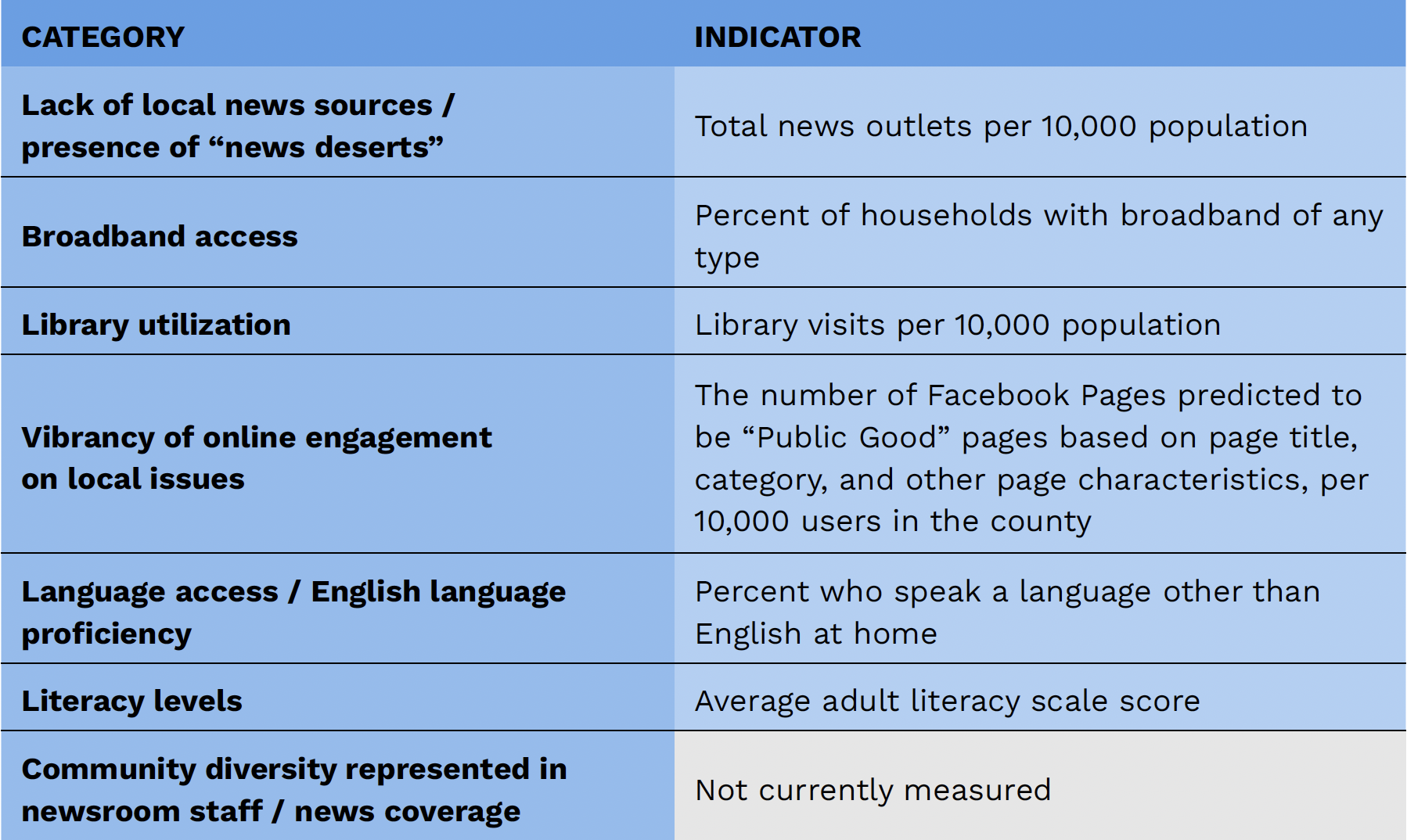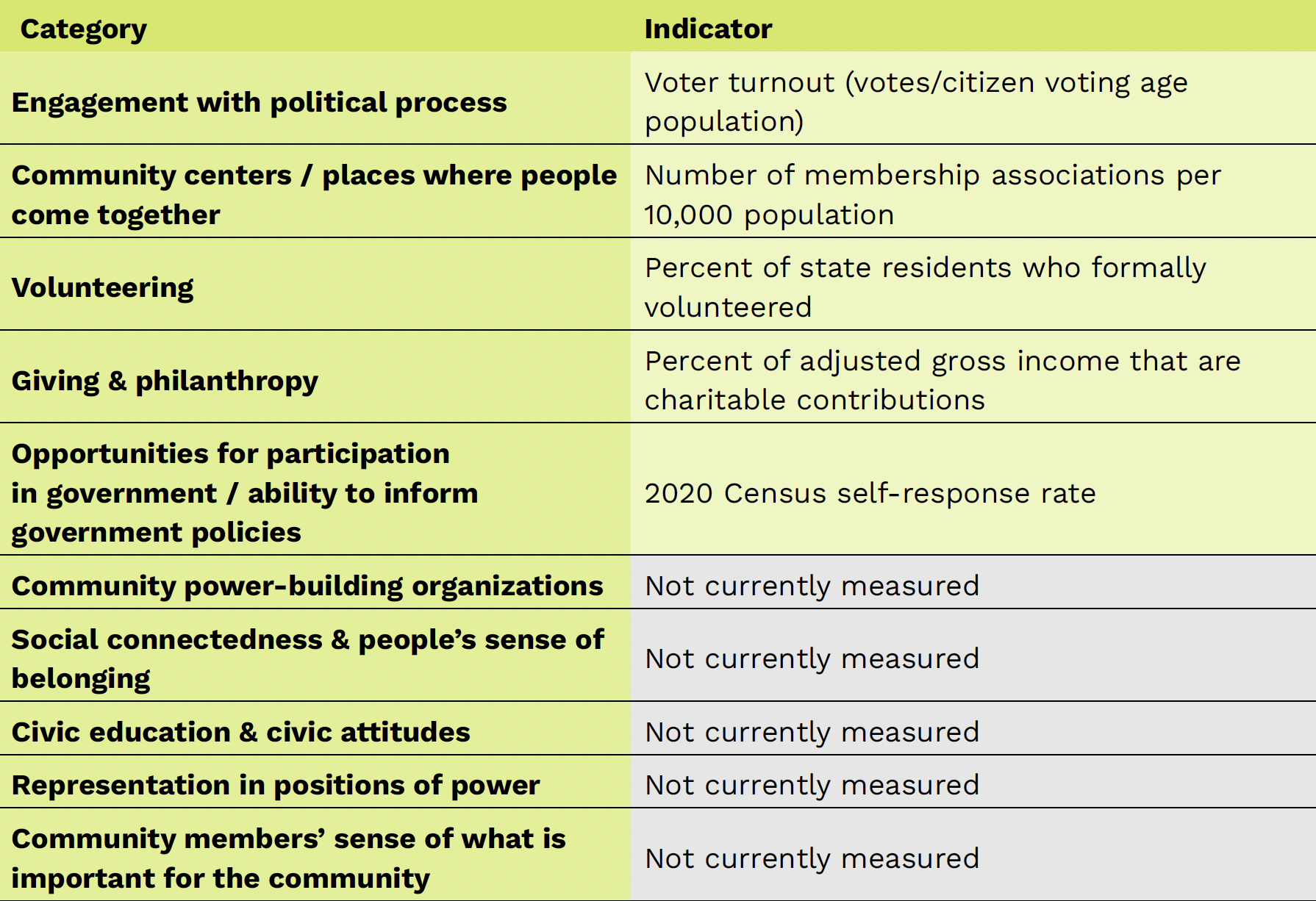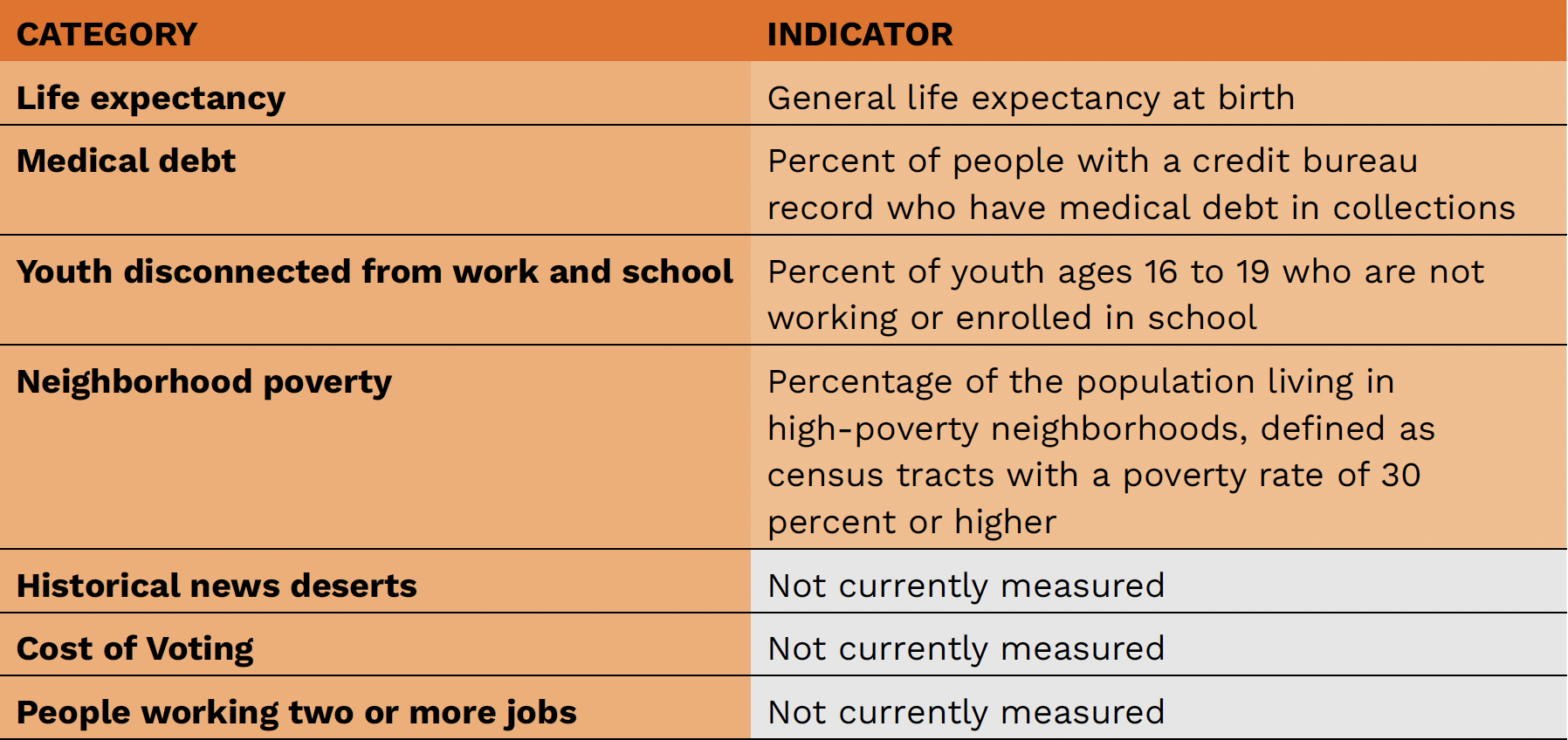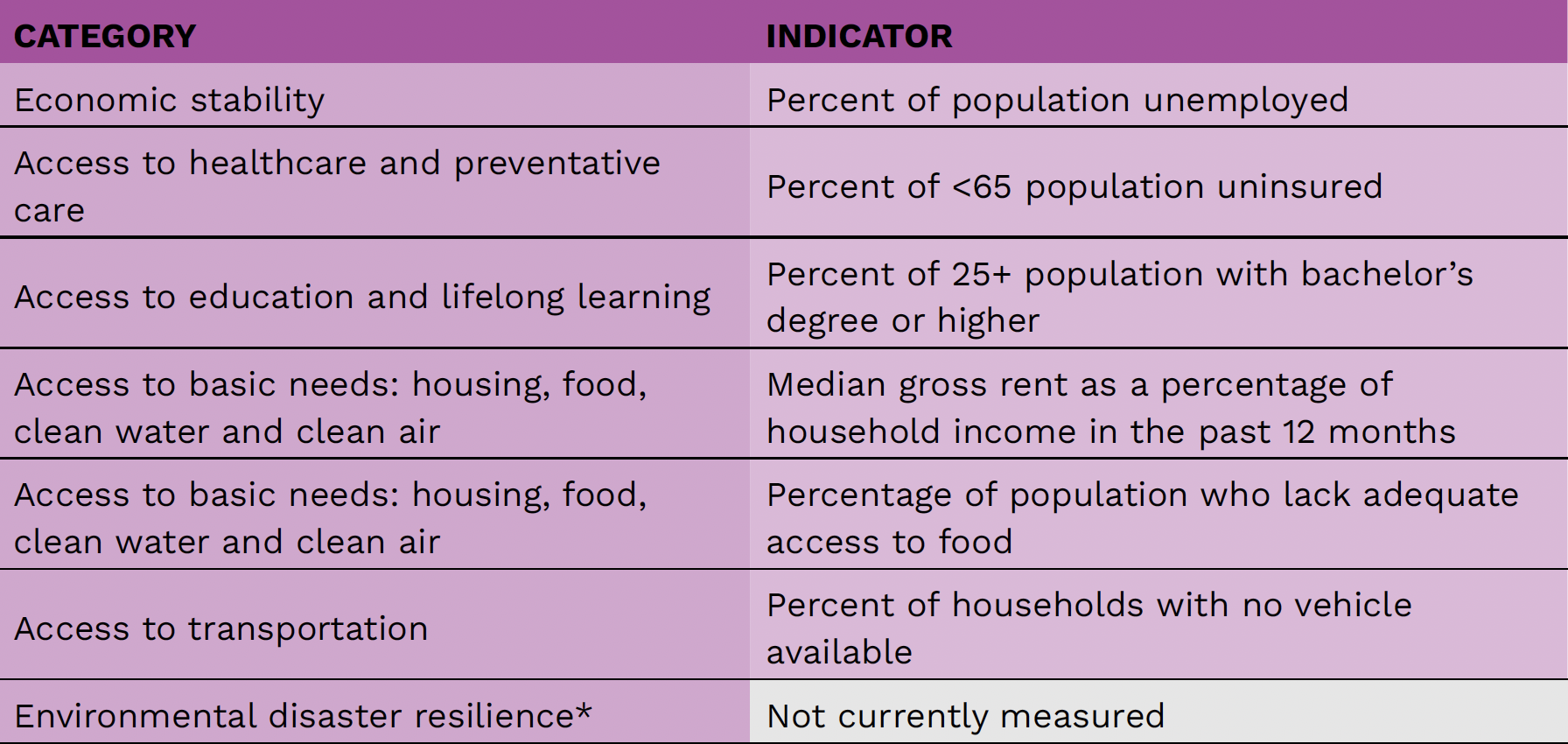The Framework
Traditionally, assessments of civic health have included basic components of civic engagement such as voter participation and charitable donations.
More recently, advocates from different groups have highlighted the importance of including measures such as news deserts and broadband access, housing insecurity, or disconnected youth.
By recognizing and connecting these often-siloed efforts, the Index framework provides a more comprehensive view of the drivers of civic health, and what it takes to build engaged, informed, healthy and equitable communities.
“Establishing this as an ecosystem is essential. We need to measure things that aren’t currently being measured to understand their true impact on community health and engagement.”
 Matt Leighninger, Director, National Civic League
Matt Leighninger, Director, National Civic League
What is Civic Health?
The National Conference on Citizenship defines civic health as “the degree to which citizens participate in their communities, from local and state governance to interactions with friends or family; civic health relates to the overall well-being of neighborhoods, communities, states and the nation.”
The Civic Information Index makes this foundation — the overall well-being of neighborhoods, communities, states and the nation that fosters freedom and collective self-governance — visible and measurable in new ways.
“There’s a great opportunity to build awareness about the critical role of media in supporting healthy, engaged communities. This work helps highlight the interconnectedness of different facets of our lives and how they contribute to civic health. It’s essential for journalism to be part of this ecosystem, serving the community transparently and truthfully.”
 Madeleine Bair, Founding Director, El Tímpano
Madeleine Bair, Founding Director, El Tímpano
Revitalizing journalism through a focus on civic health
“It is when we speak about civic health and what makes communities thrive that people get interested. Talking about news as a part of our civic muscle, that really resonates.”
 Paulette Brown-Hinds, Founder, Voice Media Ventures
Paulette Brown-Hinds, Founder, Voice Media Ventures
Today, news ventures of all kinds are a vital part of increasingly diverse local civic health ecosystems. As communities adapt to rapid societal, political, technological and environmental change, local news organizations connect people with critical information, verify and contextualize the news, and hold the powerful accountable. But they don’t do so in isolation. Local advocacy and power-building movements, community organizations, grassroots initiatives and others work alongside journalists and civic media with the shared goal of strengthening discourse, transparency, engagement, accountability — and ultimately, equitable outcomes for all.
Historically, traditional news organizations often have not served all parts of their communities equally, leaving behind those needing transparency, accountability and quality information the most. To this day, too many newsrooms fail to reflect the diversity of the communities they serve. Advocates continue to press for better representation, and more and more nuanced coverage of the issues and challenges experienced by communities confronting racial, economic, and other forms of discrimination.
“It became very clear at the onset of the pandemic, when lockdowns were first ordered here in North Carolina, that our media ecosystem was not equipped to get essential information to the people. It was community organizations and trusted messengers, including community news organizations, who did.”
 Lizzy Hazeltine, Director, North Carolina Local News Lab Fund
Lizzy Hazeltine, Director, North Carolina Local News Lab Fund
Similarly, outdated news delivery mechanisms can create new barriers to information access and vulnerabilities for people who, for instance, can’t afford to get behind a paywall, who have low levels of trust in news and authorities, or who come from a different language and cultural context.
There is an urgent need for news media organizations to better listen to and understand civic health at the local level. It is the first step to creating more reflective, responsive and community-centered news and information projects that support and are supported by the communities they serve.
At the same time, recognizing journalism as a part of the broader civic health ecosystem opens up important opportunities. It allows shifting conversations about the need for independent news from an abstract plea to “save journalism” to very concrete examples of how journalism can support and benefit people and communities. It allows news organizations to reconnect with community members, explore how to best serve local information needs, and rebuild trust. It makes journalism more collaborative, more informed, more effective — and sustainable.
“It’s time for news organizations to think beyond just reporting. They should be part of the community, engaging and gathering feedback, and helping to build a healthier information ecosystem.”
 Amanda Zamora, Co-Founder, The 19th
Amanda Zamora, Co-Founder, The 19th
The Index Framework
The Civic Information Index is based on a conceptual framework that organizes the civic health ecosystem into four pillars:
1. News and Information
2. Civic Participation Ecosystem
3. Equity and Justice (Structural Determinants)
4. Health and Opportunity (Social Determinants)
“In places like Baltimore, where infrastructures are threadbare, civic participation thrives through cultural practices like block parties, neighborhood meetings and parades where people can also register to vote.”
 Kali-Ahset Amen, Executive Director, Center for Journalism & Democracy, Howard University
Kali-Ahset Amen, Executive Director, Center for Journalism & Democracy, Howard University
The Index framework acknowledges that civic engagement should flow from a foundation of equity, not injustice. Civic engagement, for example through power building, can thrive in response to injustice. As such, some measures of civic engagement may be high in some communities where people are speaking up and building resilience to the adversity they face. This is essential to self-advocacy and democratic change. It should be regarded as a necessary path to equity; elements of civic engagement may be high but civic health overall may still be low. The ultimate goal of a free and fair democracy is for civic health to flourish from a foundation of equity.
By including structural determinants such as neighborhood poverty, youth disconnected from school or work and life expectancy, the Index is built to capture such dynamics and show where outcomes are inequitable.
The Four Pillars of Civic Health
The Index framework provides key data points — also called indicators — within each of the four pillars of the civic health ecosystem. Better outcomes on these indicators means a community has higher civic health. Sometimes, an indicator was found to be essential to civic health — such as people’s sense of belonging — but no quality data to measure it was available for all or most counties in the U.S. In these cases, the indicator is still included in the framework but marked as “not currently measured.” We encourage local efforts to investigate if nationally missing data may be available for their communities.
1. News and Information
Vision
People have access to and engage with trustworthy, credible information about issues affecting their lives and communities. Information is available in ways that meet community members’ cultural context, consumption habits, languages spoken and information needs — and is delivered by sources they trust. The information infrastructure promotes an inclusive and equitable public sphere. Digital and media literacy are part of public education and support for public service media is sufficient to meet community information needs. Journalism is independent, journalists are safe, and the media landscape is representative of and supported by the community.
How the Index frames and measures news and information:

2. Civic Participation Ecosystem
Vision
People have opportunities to participate in civic life and they do so with some frequency. People are represented equally, their voices are heard, and they are able to shape programs and policies that affect them. The community is governed by a functioning, representative government and elections are free and fair. Processes are in place for all community members to be able to provide input on a sustained basis and access information that connects them to basic public services. People feel connected and know how they can get engaged — be that in the political process, volunteering, community engagement, advocacy, or other ways to serve, lead and affect change.
How the Index frames and measures civic participation and civic life:

3. Equity and Justice (Structural Determinants)
Vision
People are free of structural barriers to civic engagement, accountability and change. Regardless of race or ethnicity, physical or mental abilities, age, gender or other factors, all people have equal access to civic life and opportunity. Structural racism, ableism, economic discrimination and other forms of oppression are dismantled, and all members of a community are able to thrive.
How the Index frames and measures civic participation and civic life:

4. Health and Opportunity (Social Determinants)
Vision
People have access to the basic foundations of a healthy life, which are essential to people’s ability to sustainably participate in society. This includes economic stability; community connection and safety; access to healthcare, education, transportation and basic needs (housing, food, clean water and clean air); and environmental disaster resilience.
How the Index frames and measures health and opportunities:

*NOTE: The Index does not currently include direct indicators of environmental or climate-related threats or readiness, such as tree cover or access to clean air. Once a full dashboard is developed, it will allow users to overlay Index scores with available data on factors such as extreme heat, fire, floods, storms, sea level rise.
